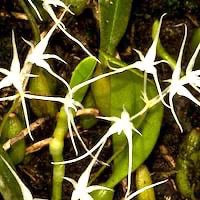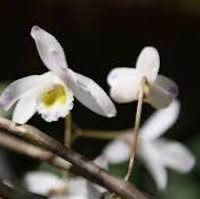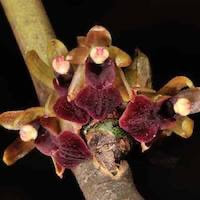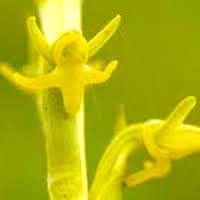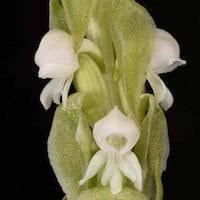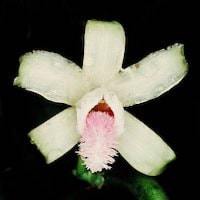WOR8- Women's Oriental 8 - 100 Per-Scent pure love
|
Native Singaporean Orchid notes: Sophrocattleya love knot-
Sophrocattleya 'Love Knot' is featured in the Oriental 8 (Women) fragrance for team-building perfume workshops. This orchid variety produces deep red to purple flowers and is known for its compact size with relatively large, fragrant blooms. Its aromatic flowers contribute to the perfume's composition, adding a rich and captivating scent that enhances the olfactory experience during the workshop.
|
Therapeutic Orchid notes:
|
Bulbophyllum kwangtungense
Bulbophyllum kwangtungense, known as Guangdongshidou Lan (Guangdong Province stone bean orchid) in Chinese, is a small orchid species that flowers from May to August and thrives on rocks in forests across China, Hong Kong, and Lantau Islands. It holds significant medicinal value; its fresh or steamed and powdered pseudobulbs are used in traditional medicine to treat coughs, reduce heat, clear wind, and alleviate convulsions in children. The herb is also employed for ailments such as rheumatism, arthritic pain, traumatic injuries, and mastitis, with caution recommended for individuals with a cold constitution. Bulbophyllum kwangtungense contains compounds like Cumulatin and dibenz[b,f]oxepins, which exhibit antitumor properties against human tumor cell lines, highlighting its potential in medicinal research and applications. |
|
Dendrobium amoenum Wall ex Lindl.
Dendrobium amoenum Wall ex Lindl., an orchid species spanning from the Himalayas to Myanmar, holds medicinal significance in traditional practices. In Nepal, its stems are prized for their tonic properties, boosting overall health. Additionally, its pseudobulbs are processed into a healing paste for burns and dislocated bones, offering soothing relief. Passed down through generations, this botanical's healing prowess underscores its cultural importance and efficacy, blending ancient wisdom with modern health practices for continued reverence and use. |
|
Luisia trichorrhiza (Hook.) Blume
Luisia trichorrhiza (Hook.) Blume, known as "Arjona" in Nepal and "Kluai nam thai" in Thailand, is a versatile orchid celebrated for its medicinal benefits. In Nepal, its paste relieves muscle pain, offering comfort to those suffering from discomfort. Thais use the entire plant to treat liver issues and diabetes, integral to their healing practices. Bangladesh utilizes its roots for jaundice, muscle pain, and diarrhea. Phytochemical analysis reveals trace alkaloids, potentially enhancing its therapeutic properties across traditional medicine practices, highlighting its role in natural healing traditions. |
|
Peristylus densus (Lindl.) Santapau and Kapadia syn. Platanthera stenostachya Lindl.
Peristylus densus (Lindl.) Santapau and Kapadia, known by several Chinese names including Xiasuikuorui Lan, Xiasuilu Lan, Xiasuishechun Lan (narrow tassel tongue lip orchid), Xiasuilu Lan (narrow tassel heron orchid), and Xiasuiyufenghua (narrow tassel jade phoenix flower), is a valuable orchid species sourced primarily from southwest China for traditional herbal medicine. It is prescribed in Yunnan Shi Mao Chinese Traditional Medicine in doses of 15–30 grams, often cooked with meat to enhance its therapeutic effects. In Chinese herbal practice, Peristylus densus is esteemed for its ability to alleviate physical weakness, strengthen the stomach and spleen, and improve digestion, particularly beneficial for children with nutritional deficiencies and digestive issues. Additionally, it is used to treat diarrhea and rheumatism, showcasing its importance in traditional medicine for promoting health and treating various ailments. |
|
Satyrium nepalense var. ciliatum (Lindl.) Hook. f.
Satyrium nepalense var. ciliatum (Lindl.) Hook. f., known as Yuanmaoniaozu Lan (hair-edged bird feet orchid) in Chinese traditional medicine, is an orchid species prized for its medicinal benefits. It blooms with elegant pink flowers from August to October in China. The stem of this orchid is particularly valued for its ability to strengthen the loins and invigorate the kidneys, promoting kidney health and enhancing blood circulation. It is also used to calm the mind, aiding in mental tranquility. Medicinally, Yuanmaoniaozu Lan treats nephritis, strengthens weak kidneys, alleviates backaches, reduces facial and leg swellings, and is utilized in managing heart disease, highlighting its role in traditional healing practices for overall well-being. |
|
Vanilla aphylla Blume
Vanilla aphylla Blume, known by various Thai names like Khot nok kut (in Surat Thani), Khruea ngu khieo (in Nakhon Ratchasima), and Thau ngu khieo (in Saraburi), is a unique orchid with dark green, flattened stems. It grows in southern Thailand, Myanmar, Indochina, northern Peninsular Malaysia, and Java. In traditional Thai medicine, its stem is prized for treating liver issues. Local healers value its effectiveness in addressing liver dysfunction, passing down this knowledge through generations as part of Thailand's rich herbal heritage, highlighting its role in promoting health and well-being. |
Other scent note
Scentopia Library Reference ingredient
Vanilla - Sir Raffles Collection - Check details at Scentopia's scent library
Download the guided mediation that works best with this Orchid fragrance oil
| women_oriental_essential_oil_orchi_00008.mp3 | |
| File Size: | 68342 kb |
| File Type: | mp3 |

